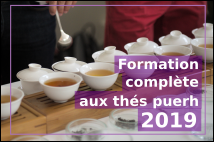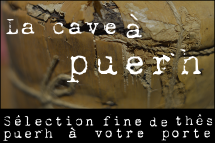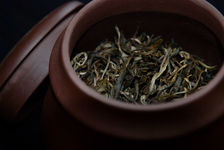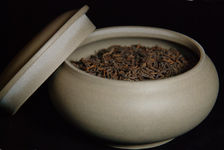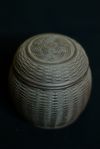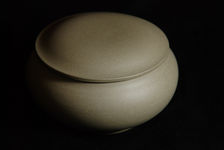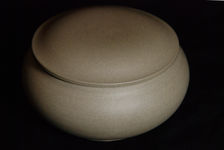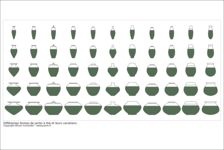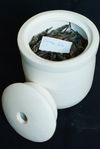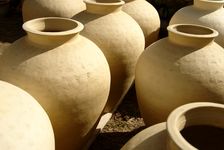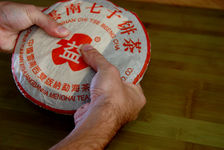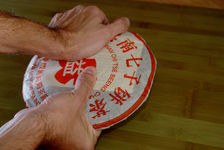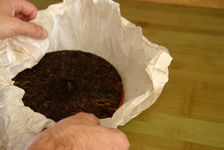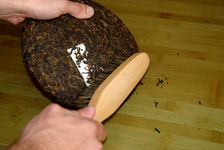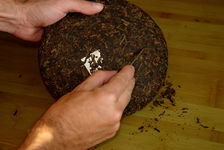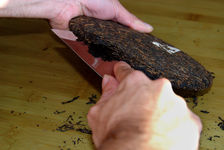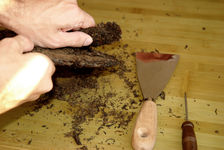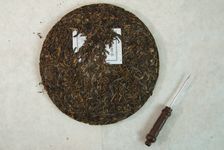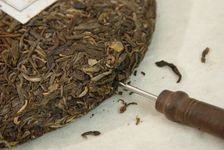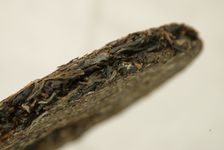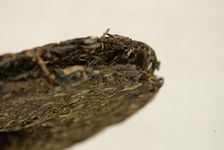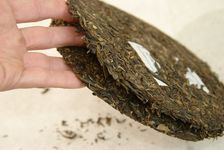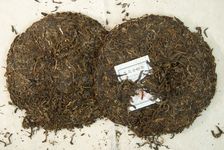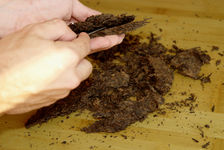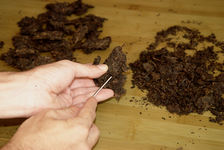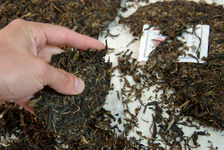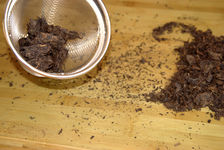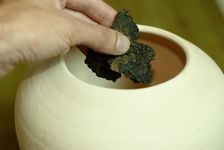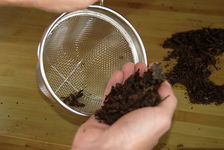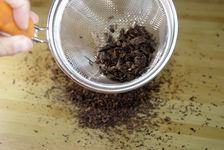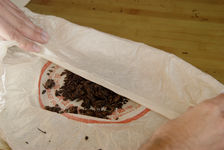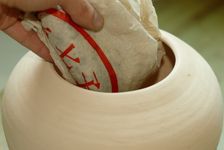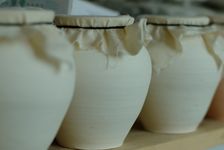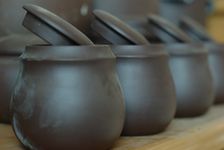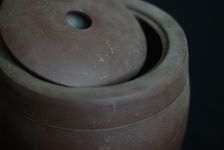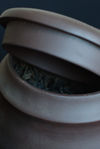 This page is not a real translation but just an automatic translation generated by computer of the original article, written in French language! Its not good... but better than nothing!
This page is not a real translation but just an automatic translation generated by computer of the original article, written in French language! Its not good... but better than nothing!Want to help us do diffuse puerh tea culture in english, by providing a better (or corrected) translation?
Please contact us!

The tea is usually kept puerh (Pu Er tea) so compressed, either in the form of pancake (bing cha), bricks (zhuan cha), bowl (tuo cha) or mushroom (jin cha).


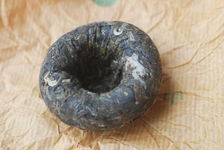

- 1. Tea puerh (Pu Er tea) compressed shaped wafer (bing cha)
- 2. The puerh (Pu Er tea) compressed shaped brick (zhuan cha)
- 3. The compressed puerh (Pu Er tea) bowl-shaped (tuo cha)
- 4.Tea puerh (Pu Er tea) compressed mushroom (jin cha)
These forms are first practices, they reduce the space taken up by the leaves of tea and make handling of different teas from its "cellar" easier. But these forms compressed, packed porous materials such as paper or slab of bamboo tong, also allow good conservation and good aging puerh, who are in need of being in contact with air, unlike the majority of the teas that prefer storage at the shelter air.


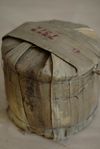
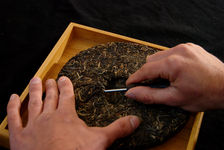
- 1. Packing a porous cake puerh
- 2. Packing a cake puerh (Pu Er tea) (detail)
- 3. Tong puerh (Pu Er tea) bamboo sheet
- 4. Extraction of a fragment of a cake for consumption
We therefore usually draws a few grams of tea in such and such a cake when preparing his tea as it is detailed in this article , then repackages carefully to keep his cake .
This is not the only possible approach, and it is also possible to break fully or partially for her cake store in jar. If the jar is almost unavoidable for the storage of bulk puerh, being put in a jar puerh (Pu Er tea) initially compressed will affect the conservation of tea, and is practiced consciously, as for example a wine decanter to aerate before eating.
Why put her in puerh (Pu Er tea) jar
The question does not really arise for a puerh (Pu Er tea) bulk. Since bulk of fact must be kept in a container and the jar seems quite naturally be a good answer to that. It may seem more surprising against by putting in a piece of cake puerh (Pu Er tea) to remake the bulk, because it is ultimately more of what this is about, the jar is merely a consequence of the re-commissioning bulk of puerh.
The practical aspect of the jar
The implementation of puerh (Pu Er tea) jar was first a very practical purpose. If it is larger and less convenient to carry it makes against the use by the infusion of puerh (Pu Er tea) easier. In places because of having to retrieve a piece of cake from his puerh (Pu Er tea) before each infusion, some prefer to once and for all their bulk wafers. Suffice it and when you want to eat this or that tea to open the jar corresponding to extract a few leaves or a piece of cake to the desired size, then the brew. We thus find somehow the practical aspect of size as the mini tuo, with all the variety and quality of available puerh (Pu Er tea) into patties.
But beyond the practical setting of a jar puerh (Pu Er tea) compressed to influence its conservation and its flavors, and is generally practiced for this purpose.
The case of aged puerh: the revitalization
It's common and preferred when one started a cake-old put the bulk some time before drinking, to maximize its flavor and character, this is what we call the revitalization (not confused with the revival). Natural conditions experienced by patty during maturation are indeed not homogeneous, especially between the wafer surface where tea is in direct contact with the air and the heart of the plate, creating disparities in the cake.
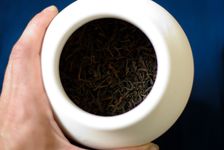
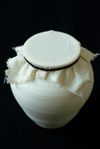
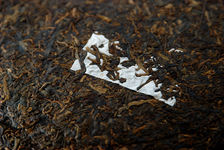
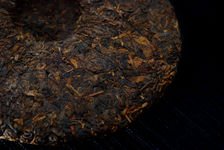
- 1. Revitalization in a jar of old tea
- 3. Disparities in a cake (2001 against 7572)
- 4. Disparities within a wafer (7572 2001 front)
In addition to these disparities in the maturation of puerh, some cakes, and especially the great productions of recent decades are not compressed uniformly. Generally take place on the surface of the finest leaves, and buds for grades, while the leaves are larger and more present in the heart at the back of the wafer, causing disparities buds again depending on how it starts the cake, disparities tend to widen over time.
In addition the heart of the plate, less airy than the surface, after a long storage period needs to be aired fully expressed.
This is why a cake fresh from his old store will be better after a phase of revitalization in that jar by simply extracting a piece at the time of consumption. The amateur and usually choose to break all of her cake as we shall see later, to mix the different leaves from different parts of the cake, then keep them in a breathable container such that a jar, a basket of woven bamboo or simply a sheet of paper folded puerh.
This allows first homogenize the leaves from the different part of the cake, but also to balance their characters by letting them soak up their respective flavors. But it also just tea to breathe, to wake up his character, especially after long storage, and aromas arise.
The duration depends on the revitalization of tea, its degree of compression, duration of storage, climatic conditions, etc., and usually takes a few weeks. When the aroma of tea aparaissent as assertive, stable, rich and full, revitalization can be considered complete and ready to drink tea.
The case of young puerh: accentuate the maturation
Unlike the amateur may be tempted to put in a jar puerh (Pu Er tea) young, to promote its maturation. Puerh processing depends on its contact with air. A puerh (Pu Er tea) bulk as a Maocha evolve more quickly and more significantly a puerh (Pu Er tea) compressed. This is particularly why some producers choose to let it age a few years their tea as Maocha before compressing into a disc, thus favoring older flavors of tea.
So by putting in a bulk wafer puerh (Pu Er tea) young, then storing it in a breathable container such as a suitable jar is accelerated maturation and promotes the characters mature tea.
Which jar to use
The aim of bulking the puerh (Pu Er tea) is particular to allow a better ventilation than the leaves allow the compressed forms, and one of the main criteria for choosing the jar will naturally its air permeability.
Few thoughts jars for aging puerh, the vast majority of jars on the market have also been developed for other teas such as green tea or wulong and are often poorly suited to tea puerh. This is firstly the lack of recognition of puerh (Pu Er tea) against other major Chinese teas, but also the ignorance of pottery Yunnan face mythical places like China Yixing pottery.
However, there are some villages in Yunnan potters who work the land particularly suited to tea puerh. This is particularly the case of Wan Yao Cun area Lincang, a small village potter who owns land and a pottery technique particularly suitable for the manufacture of puerh (Pu Er tea) jars, jars and excellent product for this purpose. Best known in the region of Lincang, some producers pointed to the region and their Maocha store in the land of Yao Wan before compression, to promote the early years of maturation.
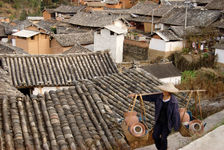
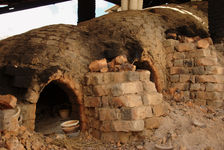
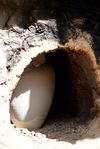
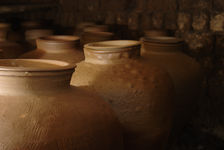
- 1. Wan Yao Cun, a village of potters in Lincang, Yunnan
- 2. Four wooden dragon Wan Yao Cun
- 3. Big jar in an oven puerh (Pu Er tea) Wan Yao Cun
- 4. Jars to puerh (Pu Er tea) earthen Yao Wan
After a year in working with potters Yao Wan, and experimented with different combination of soil and temperature of cooking, so we have designed and produced last year with one of the best village potter series of jars specifically designed to optimize the storage and aging of tea puerh. Firstly for the storage of fat in the long run, I have recently derived the jars in smaller models to allow a home storage.
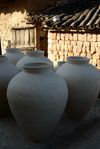
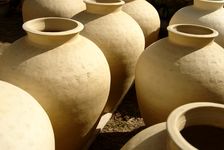
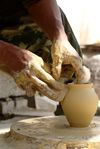
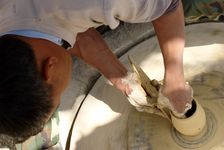
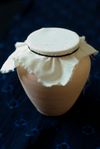
- 1. Big puerh (Pu Er tea) earthen jar of Yao Wan
- 3. Making a small earthen jar puerh (Pu Er tea) Yao Wan
- 5. Small jar of clay puerh (Pu Er tea) Yao Wan
Material
As we have already seen the jar must have good air permeability to allow the puerh (Pu Er tea) breathe, as permitted by the papers in which are packed patties puerh (Pu Er tea) or bamboo leaves that form the tong.
Therefore be avoided a priori materials such as porcelain, more suited to wulong. Similarly many lands, including Yixing, offer poor air permeability and are not ideal aging tea puerh. Also be avoided land enamelled, varnished or painted, these treatment reduces or nullifies the natural porosity of the earth.
Puerh storage jars in such low porosity is still possible, especially if they are closed with a porous fabric (not a cover of earth), where taking care of regularly airing the jars as we will see later.
The ideal is still where it is possible to use a land of high porosity, as the land of Yao Wan fired at low temperature, allowing a better exchange between tea and the external environment.
There are several ways to judge the porosity of a jar.
In some cases with very porous jars you can breathe through the wall of the jar. Place your lips on the wall of the jar and draw (very) strongly, you should feel that the air passes through the walls of the jar to get to your mouth.
Another method is to fill the water jar. A highly porous soil is generally not water-tight. After some time you should feel the humidity outside of the jar, which according to the land will be accompanied by a color change. The water gradually through the walls of the jar you can sometimes see small drops of water appear and beading on the outside of your jar before it is completely covered with a thin layer of water.
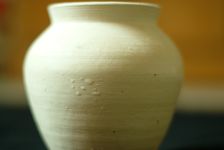
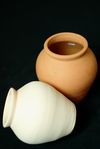
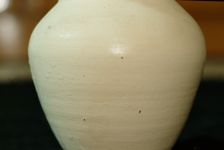
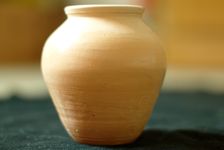
- 1. Drops appearing on the surface of a porous jar full of water
- 2. Example of color change of a porous water-filled jar
- 3. Surface of a wet jar puerh (Pu Er tea) filled with water
- 4. wet surface of a jar filled with water to puerh
Size
The size of the jar must naturally be adapted to the amount of tea it contains. Generally it is best not to completely fill the jar, and do not fill such that the two-thirds, to allow more air into the jar and maximize contact with the air leaves.
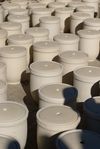
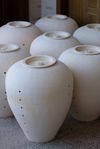
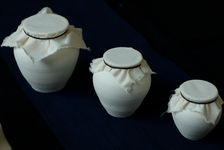
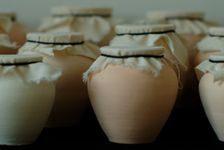
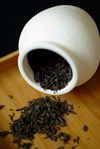
- 1. Large jars puerh (Pu Er tea) for long term storage
- 3. Different sizes of jars puerh (Pu Er tea) for home use
- 4. different sizes of jars puerh (Pu Er tea) for home use
- 5. Small jar puerh
However if this is true for a long-term storage, in the case of a jar in common use can be anticipated that the tea will decrease anyway gradually as and when it is consumed and more fill the jar .
Very well made teas, as the puerh (Pu Er tea) Maocha Gross, naturally leave a large ventilation between the leaves and does not necessarily require additional space at the top of the jar.
Form
The shape of the jar also has a particular importance and influence on contact with air tea leaves. Preference is usually flared forms, which allow greater contact surface that forms thin and elongated.
More than the shape of the jar is, how close is this one was decisive when the effectiveness of the jar for storage of any tea.
Always allow for leaf respiration should be avoided for storage of the sealed jars or puerh (Pu Er tea) that close in a completely sealed, the jars being more suitable for the storage of wulong, and jars are preferred to cover rudimentary or punctured, leaving a stream of air to circulate.
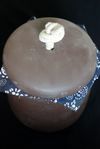
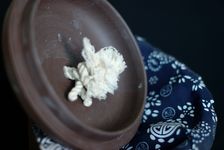
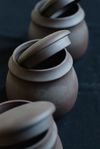
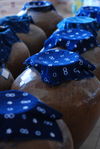
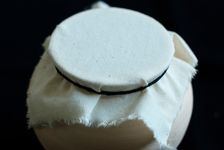
- 1. Example of non-hermetic closure of a tea jar
- 3. Between opening jars for air
- 4. Closure of a jar with a piece of tissue
The ideal for storing jars puerh (Pu Er tea) remains that, at sites close with a lid in the ground, close with a piece of fabric taut. Indeed, while the tissue that prevents dust from entering the jar it leaves the tea breathe fully, in the manner of packaging a wafer puerh.
Alternative to jar
As stated previously the main setting in a jar in puerh (Pu Er tea) wafer is foremost, the bulk of the wafer. If a suitable jar is undoubtedly the ideal container for storage of puerh (Pu Er tea) alternatives also work very well.
You can first make use of woven bamboo baskets, whose surface is particularly breathable.
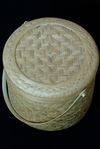
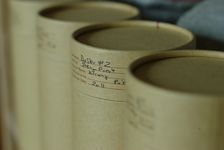
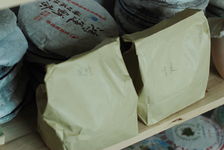
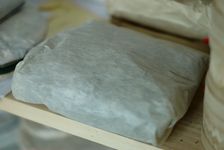
- 1. Example of a bamboo basket for convenient storage of puerh
- 2. cardboard tubes designed for the storage of puerh
- 3. Storage of puerh (Pu Er tea) in pockets in porous paper craft
- 4. Storage of puerh (Pu Er tea) loose in a sheet of paper puerh
Some cards, if they are not covered airtight craft, also allow a good porosity and can be good for container storage puerh, whether it's planned for that tube or simple boxes.
Some pockets in natural paper, or craft, also allow the tea to breathe and can be used for storing tea puerh.
Finally it is also quite possible to use for storage of bulk puerh (Pu Er tea) single sheets of paper puerh, such as those used to package cake. Suffice it in this case to lay the tea leaves and then close the like a large envelope.
How to put puerh (Pu Er tea) in his jar?
It there's various ways of putting a slab of bulk puerh. The aim of the operation is of course to best comply with the sheets comprising the slab, ie not to break or damage them, but also to lose as little as possible of tea. The method we will see today is probably one of the most effective and respectful for tea.
We also take care to adapt his movements and some steps to the nature of tea: A tea very compressed, especially fermented, usually separates into small nuggets of several grams, which is stored in a jar and thus that the we infuse unchanged during the tasting. Conversely puerh (Pu Er tea) a little compressed, especially raw, can separate one sheet and return to something close to the tea leaves before compression.
We will see it step by step with the setting part of two very different cakes. The first is a Menghai Da Yi Tea Factory 7572 Red Fermented 2001. The second is a slab of raw puerh (Pu Er tea) Lincang produced by De Yong Zi Yu in 2006.
And for those who prefer even this by video:
How to store your puerh (Pu Er tea) tea in jars?
Keep your tea jars in a clean and odorless. In the case of a long-term storage it is best to open the jars regularly to assess the evolution of maturation, and blending of tea leaves.
Similarly if your jars are not suitable for puerh, it is highly recommended to regularly air. Entrouvrez just why the lid of your jar occasionally to allow air to renew. If you want the post-fermentation are promoting your puerh (Pu Er tea) you can choose to ventilate your jars of rainy days where the humidity is higher.
It'll just sip your tea and put in jar!

